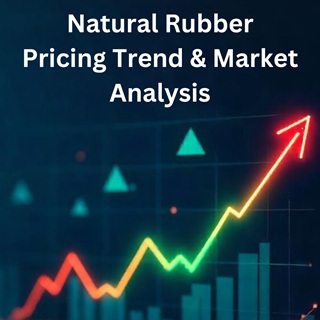Navigating the Natural Rubber Pricing Trend in 2025: Key Insights and Projections

Strong 8k brings an ultra-HD IPTV experience to your living room and your pocket.
Natural rubber is one of the most crucial raw materials in the global economy, found in everything from car tires to medical supplies. As industries evolve and the world faces new challenges, understanding the pricing trends of natural rubber becomes increasingly important. For businesses that rely on natural rubber, the ability to predict pricing fluctuations can lead to better strategic decisions and smoother operations. In this article, we will explore what factors are expected to influence natural rubber prices in 2025, including global demand, climate change, sustainability efforts, and economic shifts.
The Rise in Demand for Natural Rubber
The demand for natural rubber is expected to grow in the coming years due to increasing needs in several key sectors. The automotive industry remains the largest consumer of rubber, especially in tire manufacturing. With the number of vehicles on the road steadily increasing, and with more emphasis on electric vehicles (EVs), tire demand is set to grow. Even though electric cars generally use fewer tires than their traditional counterparts, the overall growth of the EV market is expected to add to the demand for natural rubber.
Aside from the automotive sector, natural rubber plays an essential role in various healthcare products, especially medical gloves, which have seen a surge in demand during the COVID-19 pandemic. With heightened awareness about health and hygiene, this demand for medical rubber products is expected to remain high in 2025. In addition to healthcare, industries like construction, consumer goods, and manufacturing also rely heavily on rubber for a variety of products, including seals, gaskets, and industrial machinery parts.
As these industries continue to expand and adapt, the demand for natural rubber is poised to remain strong, exerting upward pressure on pricing.
The Impact of Climate Change on Rubber Production
The rubber production process is inherently dependent on environmental factors, making it vulnerable to the effects of climate change. Southeast Asia, the leading region for natural rubber production, is already experiencing the negative impacts of extreme weather conditions. Rubber trees are sensitive to fluctuating temperatures and rainfall patterns, and sudden shifts can significantly affect yield.
For instance, severe droughts, floods, or unexpected weather patterns can destroy rubber crops or lower latex production, which would limit the overall supply. In 2025, we are likely to see the ongoing effects of climate change on rubber plantations, reducing supply and causing a sharp increase in prices as the demand for rubber continues to rise.
Farmers in the rubber industry are also being forced to adapt to changing weather conditions by altering planting practices, irrigation systems, and harvest times. These adaptations may involve greater costs, further pushing up the price of natural rubber.
Labor Challenges in Rubber-Producing Regions
The process of tapping rubber trees requires skilled labor. In many rubber-producing countries, there has been a noticeable decline in the number of workers available for rubber tapping. This shortage is primarily due to rural migration, lower wages, and a lack of interest in manual labor jobs. The COVID-19 pandemic also had a significant impact on labor availability, with many workers either migrating to urban areas or leaving the workforce altogether.
If this labor shortage persists through 2025, the production of natural rubber could be further constrained, leading to a tightening of supply. This, in turn, would push rubber prices higher. As wages increase in response to the labor shortage, the overall cost of rubber production will also rise, impacting pricing for manufacturers and consumers.
The Influence of Sustainability on Pricing
As the global community grows more conscious of environmental issues, sustainability has become a major factor influencing the rubber industry. Deforestation, land degradation, and over-reliance on harmful pesticides have raised concerns about the long-term viability of rubber plantations. As a result, there has been an increasing shift toward sustainable rubber production methods.
However, implementing these sustainable practices often requires significant investments in technology, land management, and certification processes. These additional costs are likely to be passed on to consumers in the form of higher prices. In 2025, as sustainable production becomes the industry standard, the cost of natural rubber may increase due to the added costs of producing eco-friendly rubber.
Moreover, sustainability certifications, such as those provided by the Forest Stewardship Council (FSC), can drive the cost of rubber even higher, as producers work to meet global standards for responsible and sustainable practices.
Economic Factors and Global Inflation
The global economy plays a significant role in determining the price of natural rubber. Economic growth tends to drive demand for goods, including those made from rubber. As industries like automotive, healthcare, and manufacturing continue to expand, the need for natural rubber will follow suit. However, economic downturns can result in reduced consumption, leading to lower rubber prices.
In addition to global economic growth, inflationary pressures will likely influence the pricing of natural rubber. Rising energy and transportation costs, coupled with the ongoing inflation in raw material prices, will increase the cost of producing natural rubber. As producers adjust to these rising costs, prices will inevitably increase, impacting businesses that depend on rubber for production.
Geopolitical Tensions and Trade Policies
Geopolitical instability and trade disputes also have a role to play in the natural rubber market. Trade restrictions, tariffs, or sanctions between rubber-producing countries and major importers can disrupt the global supply chain. Any political instability in Southeast Asia, where most natural rubber is produced, could result in supply shortages and price volatility.
Additionally, global supply chain disruptions caused by factors like shipping delays and rising freight costs may continue to affect natural rubber prices in 2025. These challenges could increase transportation costs, which would further raise the overall price of rubber, especially in countries dependent on imports.
Conclusion: A Price Increase on the Horizon
Looking ahead to 2025, it is clear that natural rubber prices will likely continue to rise. A combination of factors—including increasing demand from key industries, climate change, labor shortages, sustainability efforts, economic inflation, and geopolitical factors—will create an environment in which prices are driven higher. For businesses that rely on natural rubber, adapting to these price increases will require thoughtful planning and strategic procurement.
Securing long-term contracts, exploring alternative sources, and investing in sustainable practices can help mitigate the impact of rising prices. As the global natural rubber market continues to evolve, businesses that stay informed and proactive will be better positioned to navigate the coming price shifts.
Note: IndiBlogHub features both user-submitted and editorial content. We do not verify third-party contributions. Read our Disclaimer and Privacy Policyfor details.







